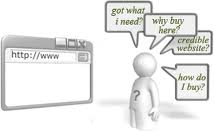Web Design Wednesdays
Stanford University Studies The Top 10 Rules for Website Credibility

How Credible Is Your Website?
In nearly every prior Web Design Wednesday blog post, we’ve discussed how the topical feature or suggestion would serve the underlying purpose of building your online credibility.
Cultivating the credibility of your website is important because in the current age, the online image of your company will be the most prominent and easily accessible representation of you available to prospective customers. Not only do their initial impressions of your website matter, but also the ways in which they perceive and respond to it long term, because this ultimately makes the difference between your enterprise establishing itself as a leader or getting passed over for competitors.
In fact, you may even find yourself questioning the various tips we share in this Los Angeles website design blog every week and wondering how credible and effective they actually are.
If you’re still finding yourself a little skeptical of my own words, take a look at how the strategies we’ve employing every day with our clients stack up against a recent study by the Stanford University Persuasive Technology Lab.
Based on three years of research analyzing related essays, publications, and the responses of over 4,500 web users, the Web Credibility Project outlines ten guidelines for creating and maintaining a credible website that reflects quality, expertise, and a client-minded philosophy.
The Project encompasses both the tangible features instantly visible on the homepage as well as those that are less obvious but nonetheless influential in how users assess the value of a business.
First, there are the more concrete immediate elements of your website that help establish credibility. The Project repeatedly mentions the simple importance of showing you’re “real.” Be honest, in the back of your mind whenever you hit the search engines for a product or service is the concern, “I don’t want to get scammed.” Hence, show your prospective customers that behind your company is a real person and not just a post office box and a bank account.
Make sure your site loads quickly and completely, and that your links are all working. Nothing says “bounce” like sluggishness and site errors. A great user-minded site is nothing if it doesn’t show up.
The notion of a “professional-looking” website is entirely relative to what you do and who your customers are. A law or management consulting site typically presents a very professional image, but that doesn’t mean that it’s an accurate reflection of you. We emphasize to our clients that a site doesn’t need to be overloaded with graphics and visual stimulation to “pop.”
Display employee bios and photos, including your own, so your expertise, professionalism, and warmth are evident. Add your physical address and even pictures of your location on every page, especially if you plan to do a lot of local business.
Have a list of the types of clients and industries with which you have worked, as well as relevant institutions that have endorsed you. You can incorporate links as well as long as they are trustworthy and functional themselves.
Once you have garnered enough of a user’s interest to get them to look around your website and even read up on you, make certain you have professionally written copy that informs and reflects your unique voice, rather than pushy, keyword-crammed fluff. Always spell and grammar check, and add new content (news items, blog posts, videos, etc.) to keep it interesting, current, and worth revisiting.
Now that you have presented a legitimate enterprise, make it simple for people to reach out to you through a clickable email, or inquiry and opt-in form. It lets you gather data about your targeted audience and gives them a much quicker option than picking up a phone, which few of us are inclined to do these days.
In looking closer at the methods of building credibility that both LADezign and Stanford research agree are valuable, you may have noticed re-occurring themes.
That is, credible business owners and their websites work from the perspectives of the customers they want to attract.
When you work with our team for example, we make a point of developing a comprehensive knowledge of who you want to work with and assembling a site that reflects this crucial insight.
This post is way beyond our usual length, so I'll bid you a Happy Jewish New Year in case we run out of steam before the Yom Kippur fast day this weekend.
P.S. Don't forget to subscribe below to this blog.
 About Jason Ciment
About Jason CimentFormerly an attorney and CPA, Jason has been working online since 1997. His columns on affiliate marketing can still be found on www.Clickz.com and his book on search engine optimization can be found at www.seotimetable.com.
This blog is published 4x per week and covers website design and SEO tips as well as a wide range of tips and advice for working and living online more efficiently and enjoyably.
-
Latest Blog Posts
- Top 40 Website Design Fundamentals
- Set up a Google Authorship profile
- How to configure cpanel and mx records to send email confirmations
- "The ‘Big Tall Sandwich’: A Recipe For Winning Online"
- Responsive Web Design: The Future of Website Design or Simply a Trend? Seo Resources
- What is SEO?
- Frequent SEO questions
- Optimization checklist
- Why we're good at SEO
- Web design tips Seo Case Studies
- AbsoluteMed.com
- ArtisanPrecast.com
- GrandpasCoffeeCakes.com








